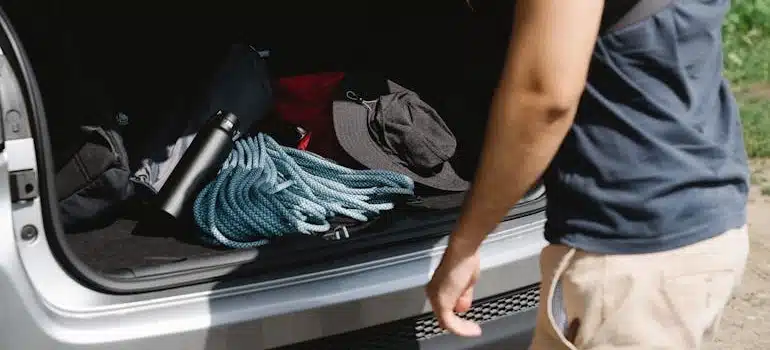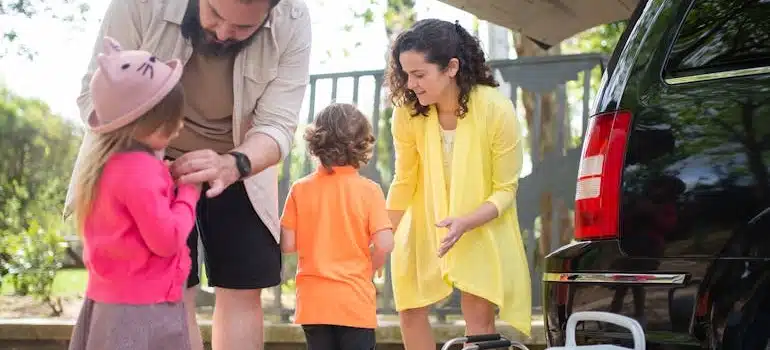Things to pack in your car when moving cross country
Packing your car for an interstate move to or from Florida takes much more than merely throwing bags into the trunk. You need a clear plan, smart space management, and a focus on safety. Our Pro Movers Miami guide shows you exactly how and what to pack in your car when moving cross country. In other words, what to bring, where to place it, and how to make the most of every inch!
Start with a packing strategy
Before placing anything in your vehicle, decide what should travel with you instead in the moving truck. Think about items you’ll need daily, valuables that shouldn’t be left unattended, and essentials for the first night in your new home.
Make a checklist. Group items by category: personal, travel, emergency, and comfort. A clear list helps you avoid overpacking, manage your moving costs, and ensures nothing important gets left behind.

Prioritize what to pack in your car
Driving out of Miami for a long-distance move means keeping key items close. Pack things that are either irreplaceable, time-sensitive, or immediately useful.
Keep these essentials in your car:
- IDs, insurance, medical records, and moving contracts
- Medications, glasses, and hygiene items
- Electronics (phones, laptops, chargers)
- Clothes for several days, including weather-appropriate options
- Snacks, water, and a small cooler for perishables
- Pet supplies, if you’re traveling with animals
- Kids’ items like games, blankets, or special toys
- Cash and cards for tolls, gas, and emergencies
Avoid loading up the car with heavy furniture, boxes meant for storage, or anything you won’t need until you arrive. Those should go with one of the reliable interstate moving companies in Miami; you don’t need bulky items slowing you down or blocking your visibility on the road.
Use the right packing materials
How to pack your car when moving is not the only thing that matters. Using the right materials makes the process faster, safer, and far more efficient. Storage cubes, backpacks, and soft-sided duffel bags make better use of space than hard suitcases.
Pack flexible containers that mold to the shape of the car’s interior. Use vacuum-sealed bags for clothing and soft items to save room. Trash bags or thin plastic totes can hold loose items, but may shift, so secure them carefully. Line the trunk with a non-slip mat to prevent bags from sliding.
Pack your car efficiently and safely
Once you’ve chosen what to bring, it’s time to load everything in a way that keeps your car balanced, accessible, and safe to drive. How you pack can affect gas mileage, visibility, and even how tired you feel during the drive.
Start with heavier items
You should place heavier items like tool kits, large duffels, or bottled water near the bottom and as close to the vehicle’s center as possible. It helps keep the car stable and reduces body roll on sharp turns.
Avoid packing anything heavy on the roof unless you use a secure roof box. Weight up high can increase wind resistance and reduce handling. If you use a roof rack, double-check that it’s rated for the weight and use strong tie-downs.
Use every available space
The footwells behind the front seats are ideal for small bags, shoes, or rolled-up blankets. Slide flat items under the seats if they don’t interfere with movement. Keep the backseat organized with bins or soft bags, stacking them from largest to smallest. Don’t wedge things in a way that blocks seatbelts or air vents.

Keep essentials within reach
You’ll need access to certain items throughout the drive. Place frequently used things in the glove box, center console, or a travel tote that rides in the passenger seat.
Quick-access items include:
- Phone chargers and maps
- Sunglasses and sunscreen
- Snacks, drinks, and napkins
- Medications or motion sickness aids
- First aid kit and roadside emergency gear
Avoid stacking items so high in the back that they block the rearview mirror. Use cargo nets or seatback organizers to keep things secure.
Stay safe on the road
A packed car changes how your vehicle handles, accelerates, and brakes. Give yourself more time to stop and take curves slower than usual. Also, check your tire pressure before departure because added weight can affect inflation needs. Make sure all windows and mirrors are clear. If anything inside the car obstructs your view or rattles, rearrange it.
Refuel regularly, even if the tank isn’t empty. Remote stretches between gas stations can catch you off guard, especially in rural areas. And when parking overnight, take valuables with you and lock everything. Choose well-lit areas and park near entrances when possible.
Final prep: Realistic timeline
Packing a car for a cross-country move isn’t something to leave to the night before. If you rush, you’re likely to forget something important or overload your car with things you’ll never use along the way. Break the task into manageable steps so you stay in control from start to finish.
What your last week before the move should look like:
- 6–7 days out: Pull together essentials you can’t afford to misplace like birth certificates, legal papers, medical records, and anything your movers won’t handle.
- 4–5 days out: Buy what you still need, including extra charging cables, soft-sided bags, bungee cords, and healthy road snacks.
- 2–3 days out: Clear the car and remove sports gear, trash, or anything unrelated to the move. Give the interior a wipe-down.
- 1 day before departure: Load the heaviest items first. Add lightweight bags and fill footwells with small loose items.
- Morning of the move: Pack the cooler, devices, and anything you used overnight. Double-check that nothing blocks your rear view.
Use this timeline as a flexible guide, not a rigid schedule. The goal isn’t to pack everything fast but to pack smart. Spacing out the process lets you catch mistakes early and stay focused on what truly matters for the drive.

Pack with purpose, not just to fill space
A long-distance move from Miami starts with smart packing. Don’t let your car become a rolling storage unit. Think about what you’ll use during the drive and in the first 48 hours after arrival. Prioritize safety, comfort, access, and even professional packing services in Miami if needed.
The right choices now can save you from digging through bags at midnight in a hotel parking lot or struggling with a car that handles like a brick. Choose what to pack in your car when moving cross country with intention, and you’ll hit the road confident. No digging, no second-guessing, no regrets.
